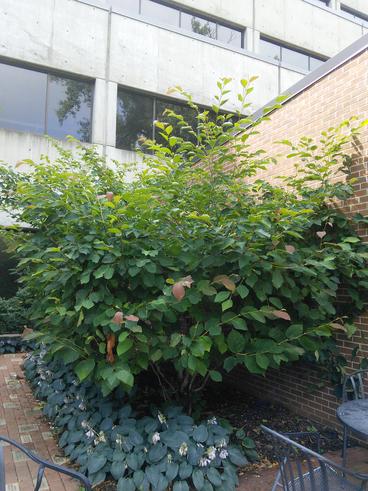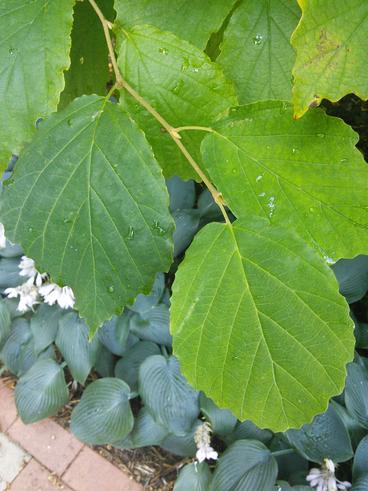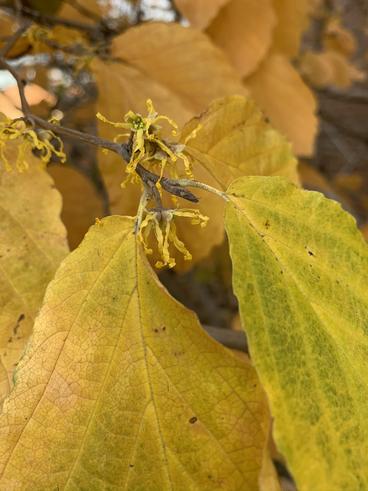
Common witch hazel, Hamamelis virginiana, is a fall-blooming, deciduous multi-stemmed shrub. There are different cultivars, but this information is only focusing on common witch hazel. More information about different cultivars of this plant can be found here.
This shrub can grow 15’ to 25’ in height and 15’ to 20’ in width. The twigs have a zig-zag shape, making the overall form of a mature witch hazel look irregular. The bark is gray with tan-colored lenticels covering the bark. The leaves are simple, in an alternate arrangement, and are oval in shape with wavy or dentate margins. Small fragrant bright yellow flowers, each with four crinkly, ribbon-shaped petals, appear from October to December. They can be present before the leaves drop and afterward. Fertilized flowers will form fruit over a long period extending through winter and into the following growing season. Fruits are greenish seed capsules that become woody with age and mature to light brown. Each seed capsule burst open in the fall of the following year, shooting the 1-2 black seeds up to 30ft away from the plant.

Witch hazel is found growing in moist well-drained soils. It thrives best in acidic, organic-rich soils but can tolerate alkaline and heavy clay soils. Witch hazel is native to woodlands, forest margins, and stream banks in eastern North America. It can be found in USDA Hardiness Zones 3 to 8. The plant can grow in full sun and full shade, but flowers best in full sun. In part-shade, it will have a more open habit than in full sun. It is one of the most salt-tolerant shrubs that are great for urban environments. It does not tolerate dry conditions. It is tolerant of black walnut toxicity and aerial salt spray.

This plant can be used for shrub bordering, screening, and hedging. It can also be used underneath utility lines. Very little pruning is needed. If pruning is required, early spring is the best time. Aromatic extract from the leaves, twigs, and bark are used in mildly astringent lotions and micellar water. The seeds are eaten by a number of species of birds. It also serves as a host plant for the larvae of the spring azure butterfly. There are no serious issues or diseases that affect witch hazel. Japanese beetles may chew on the leaves in some areas, being more of a cosmetic issue.
References:
'Common witch-hazel'. The Morton Arboretum. Found online: https://www.mortonarb.org/trees-plants/tree-plant-descriptions/common-witch-hazel
'Hamamelis virginiana'. Missouri Botanical Garden. Found online: http://www.missouribotanicalgarden.org/PlantFinder/PlantFinderDetails.aspx?taxonid=281023&isprofile=1&basic=witch%20hazel
Little, E. L. (n.d.). National Audubon Society Field Guide to North American Trees; Eastern Edition. (Original work published 1980)